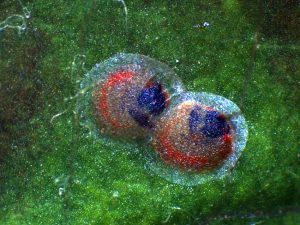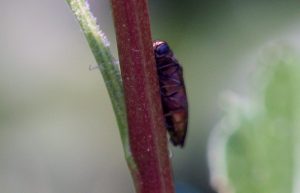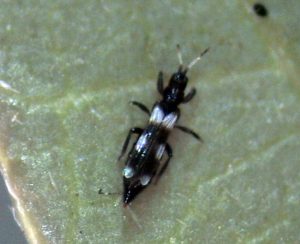In this Issue
- Apple, Pear: codling moth updated spray dates table; San Jose scale treatment dates; Leafhopper
- Peach, Apricot, Plum: peach twig borer treatment dates; Greater peachtree borer dates; Thinning peaches
- Cherry: western cherry fruit fly
- Berries: rose stem girdler on raspberry, currant, black raspberry
- Beneficial Spotlight: predatory thrips
APPLE, PEAR
Codling Moth

View a pdf of the spray timing table. Be sure to read the instructions at the top of the page, for how to read the table.
Toward the end of next week, codling moths at many northern Utah sites will be in the “period of greatest egg hatch,” where 75% of all eggs for the first generation will be hatching. Sites in southern Utah are currently in the middle of this rapid egg-laying period. Be sure to time your last spray of the first generation to protect fruit up to the end of egg hatch.
Your next spray application will then occur on the date for the start of second generation egg hatch (or if you can tolerate higher injury or have a low population, apply your next spray at the start of “second generation peak egg hatch”). These dates, if not already on the table, will be provided in a future advisory.
Treatment
- See this post for spray options for backyard growers (scroll down to Codling Moth heading and see table).
- Options for commercial growers.
San Jose Scale

San Jose scale is an armored scale (immobile insect with hard covering) that mostly occurs on apple. It can be found feeding on bark, and when populations are high, it appears on fruit as small pepper-flake spots with a purple halo. The scales are often difficult to see with the naked eye and require magnification.
We always recommend a dormant oil spray to help knock down the scale population. Ideally, the oil will smother the overwintering nymphs, whose protective “covering” is not as developed as adults. Overwintering adults will survive the dormant oil spray, and young nymphs laid by mated females (called crawlers) will need to be treated. Crawlers walk or are windblown to new sites to settle on twigs or fruit, insert their mouthparts, and feed for the remainder of their lives.
- Cache, Carbon, Iron, Summit, Uinta, Wasatch counties: July 2 – 8
- Wasatch Front: June 27 – July 4
- Grand, Kane,Wayne counties – June 14 – 28
- southern Washington County and other warm areas: June 8
Treatment
- Backyard growers can use insecticidal soap+1% oil, neem oil, GardenTech Sevin, or Spectracide Triazicide. In addition, the trunk can be scrubbed to remove the scale bodies (best done in fall or spring)
- Options for commercial growers: click here.
Leafhoppers (Commercial Producers)

Leafhoppers primarily occur on apples, but in recent years, have become more numerous on tart cherry. Start looking for leafhopper activity now, by examining leaves for typical damage (a yellow stippling pattern along the leaf veins) and turning them over to see nymphs. (Nymphs will remain on leaves while adults will fly away when disturbed.) You may also notice cast skins, which are left behind after molting.
Growers who are using acetamiprid (Assail) for codling moth or cherry fruit fly should see leafhopper control, too. Otherwise, consider Belay or Actara if warranted.
PEACH/NECTARINE, APRICOT, PLUM
Peach Twig Borer
Dates are provided for several additional sites for protection of shoots and fruit against peach twig borer.
Please see this post from May 27 for more information about peach twig borer and treatment options.
Greater Peachtree Borer

Greater peachtree borer moths lay eggs on the lower 12” of peach trunk or on nearby soil, and larvae bore through the bark and feed on the cambium. Larvae pupate the following spring, and when they emerge, they sometimes leave their pupal case stuck in the tree.
Only the lower 12″ of the trunk (down to soil line) and any exposed roots need to be protected from peachtree borer. It is also very important to remove all weeds and grass away from the trunks because the moths prefer the dark, moist egg-laying environment.
The ranges of a predicted first treatment date (or date where mating disruption should be hung) are shown below.
- Cache, Carbon, Iron, Summit, Uinta, Wasatch counties: July 6 – 11
- Wasatch Front: June 25 – July 3
- Grand, Kane,Wayne counties – June 18 – 20
- southern Washington County and other warm areas: June 8
Treatment
Female moths are actively laying eggs all summer long, so keep the trunk protected. Peach trees younger than 5 years are the most vulnerable.
- Backyard growers – the organic option is a product containing spinosad or pyrethrin (every 10 days); otherwise, use a product containing permethrin (once per month)
- Options for commercial growers who have not used mating disruption: click here.
Thinning Peaches (Residential Information)

Apple trees should already be thinned (down to a single apple per cluster, and 6 inches between fruits).
It is also time (or past time in some areas) to thin peaches (4 weeks after full bloom, or when peaches are the size of a robin’s egg). Peach trees set far more fruit than the tree can carry to harvest. Thinning the extra fruit is very important not only to get a good crop of fruit this year, but to get a decent crop next year.
- Excess fruit that remains too long on the tree will impact fruit size, formation of flower buds and crop potential for the following year, and overall tree health. An overload of peaches greatly reduces the tree’s carbohydrate reserves and can also affect the tree’s ability to withstand disease and winter injury.
- Branch breakage can also occur from the weight of too many peaches.
- Proper thinning ensures an even production of flower buds from year to year and provides larger fruit size. Although fruit will naturally drop from the tree (“June drop”), the amount is insufficient to assure optimal fruit size. Natural drops typically stem from unfertilized seed, cold injury, competition between fruit, or excessive shading.
Remove fruit by hand-twisting them off, or on taller trees, hitting unwanted fruit with children’s plastic bats, rubber hoses, or other soft object.
When thinning, pick off the smallest fruits as well as any that are mis-shaped or damaged. Then adequately space the remaining fruits to 4 to 6 inches apart. A moderate-sized peach tree should only produce 100 to 150 fruits on the entire tree.
CHERRY
Western Cherry Fruit Fly
As a reminder since the last post, treatment to prevent “worms in the cherry” should begin when fruits turn a salmon blush color.
Western cherry fruit fly is a serious pest of tart and sweet cherries. Please keep in mind that any commercial growers’ crop can be rejected by the processing plant if worms are detected. Therefore, if you have trees that are adjacent to commercial orchards, it is important they are treated for cherry fruit fly, or removed to preserve the livelihood of our farmers.
BERRIES
Rose Stem Girdler


We mentioned raspberry horntail in the last advisory. Another pest of raspberries is the rose stem girdler. It can also attack currants, black raspberry, and roses. The adult is a shiny, bronze-colored beetle. Adults are starting activity now and will be laying eggs on canes.
Females lay eggs near the base of the canes, and the larvae hatch and tunnel into the cane tissue. Canes may have swellings at the feeding sites, and infested canes may break at weak areas later in the season.
Treatment
The best treatment option is to remove and destroy infested canes late in the season and over the winter. There are a few insecticides that can be used to kill the eggs and newly hatched larvae, but use caution when spraying flowering plants by treating at dawn or dusk only to protect pollinators, or ideally, do not spray plants in bloom.
- Options for commercial and residential include: Malathion, pyrethrin (Pyrellin EC*, Bonide Liquid Pyrethrin Spray), products containing a pyrethroid (Spectracide Immunox, GardenTech Sevin, Asana, Mustang, Warrior).
- Treat two or three times, spaced 7 to 14 days apart (depending on material used)
BENEFICIAL INSECT SPOTLIGHT – PREDATORY THRIPS


The western flower thrips is a common pest of fruits, especially nectarine, where its feeding causes distorted and scabby fruit.

But other species of thrips in Utah, including the black hunter thrips, banded thrips, and six-spotted thrips, are important predators of aphids, spider mites, and pest thrips. Unfortunately, they are sensitive to pesticides, so they only contribute to biological control in unsprayed trees.
In general, the value of beneficial thrips in fruit trees is moderate. Although larvae eat 10 mite eggs per day while adults eat about 60, the predatory thrips don’t increase their population size until after prey (mites) have become abundant and damaging.
These species overwinter as adults, sheltered in trees or ground cover and emerging in late spring. Females lay eggs embedded within the leaf tissue near colonies of prey, particularly spider mites. The young thrips feed on mites over a period of 10 days and then pupate in the soil. Adults live approximately 30 days, and there are multiple generations.
Cover crops such as vetch or mustard can bring beneficial thrips into the orchard.
